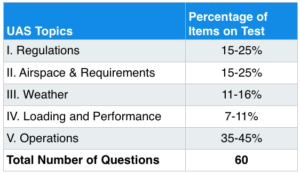The FAA Part 107 Remote Pilot Knowledge Test is no pushover, and one needs to do some serious preparation and studying to pass. But have no fear, this guide will walk your through each step of of the process.
- Remote Pilot Knowledge Test Overview
- Registration
- How To Study For The Test
- Test Taking Tips
- Frequently Asked Questions
- Resources
Remote Pilot Knowledge Test Overview
A pilot is required to pass the Remote Pilot Knowledge Test to receive a Remote Pilot Certificate with an sUAS Rating. This certificate is required for all commercial drone operations under Part 107.
The knowledge test consists 60 multiple-choice questions, with a single correct response for each test question. Each test question is independent of other questions (more test info here).
You need to score a 70% or higher to pass (must answer minimum 42 questions correctly to pass), and have 2-hours to complete it.
Here's the breakdown of the types of questions:

From many people's experience taking the test, typically the "Airspace & Requirements" and "Weather" sections are a very high percentage of the test (and generally agreed to be the most difficult).
Registration
You can register for $150 for the test at an Airman Knowledge Testing Center.
If you fail the test, you have to wait 14 days before registering and taking the test again. The test is $150 each time you take it.
Test Preparation & Studying
If you don't have any aeronautical background, most new pilots who pass the test study roughly 10-15 hours to fully understand the material.
Here's a good step-by-step process to follow if you are studying without a course:
- Study the Remote Pilot Small Unmanned Aircraft Systems Study Guide
- Take the 40 question FAA sample test using the testing supplement
- Review your answers using a solutions guide to determine your weak areas
- Study Sectional Charts, Airspace, and Weather
- Use additional resources to continue learning
Step 1: Study the FAA's Remote Pilot sUAS Study Guide
Download and review the Remote Pilot Small Unmanned Aircraft Systems Study Guide (87 pages) released by the FAA.
This is the best place to start because it gives you a very good overview of all the sections on the test, in addition to in-depth lessons and information.
Step 2: Take the 40 question FAA sample test using the testing supplement
Take the 40 question sample test released by the FAA. Use and get familiar with the official testing supplement for those questions (a hardcopy will be provided to you by your testing center).
Step 3: Review your answers using a solutions guide
Use our free PDF with detailed solutions of the sample test. It includes all 40 questions and answers to review how well you did, as well as what resources where to find the concepts you need to study more.
Step 4: Practice Questions
I would suggest DroneTribe's 300 question test bank. If you still need help with the Sectional Charts, Airspace, and Weather sections, there are also detailed Knowledge Guides.
Step 5: Use additional resources continue learning
3DR has put out sample questions and study guides that are great free resources.
Please note some of the quiz answers listed on the 3DR website are not correct, which can be frustrating.
Further reference and details on sections Pilot’s Handbook of Aeronautical Knowledge (PHAK), as well as the Part 107 Advisory Circular.
Test Taking Tips
- Think conservative with your answers
- The legend in the Testing Supplement has a wealth of information about airspace, radio frequencies, and symbols that can be used during the test
- People have the most difficultly with Sectional Charts, Airspace, and Weather
Frequently Asked Questions
Q: Is the test really as difficult as people are saying?
A: Yes - particularly if you don't have an aeronautical background.
Resources
- FAA Remote Pilot Study Guide
- FAA 40 Question Sample Test
- DroneTribe Remote Pilot Test Bank
- DroneTribe 40 Question Solutions Guide
- FAA Testing Supplement
- Legend of Testing Supplement (Page 1)
- 3DR Practice Questions and Study Guides
- Pilot’s Handbook of Aeronautical Knowledge
- Part 107 Advisory Circular
- VFR Terms and Symbols